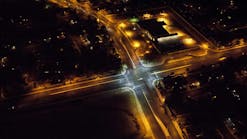Evan Mills, of Berkeley’s Environmental Energy Technologies division, notes in an article in the May 27, 2005 issue of Science that more than 1.6 billion people have no access to electricity, and many others have only intermittent access. As a result, those who can afford illumination when it’s dark rely on lamps that burn kerosene, diesel, propane, or biomass-based fuels.
Mills proposes a lighting option that developing nations might use to reduce the cost of providing effective, cleaner lighting to their citizens. “As they modernize, developing countries can select better technologies, and in so doing surpass levels of efficiency typical of industrialized nations. The latest improvement is the white LED.”
The problem with fuel-based lighting
Mills estimates that fuel-based lighting throughout the world consumes 77 billion liters of fuel annually, at a total cost of $38 billion per year, or $77 per household. This, he says, is equivalent to 1.3 million barrels of oil per day, roughly the total oil production of Indonesia, Libya, or Qatar, or half the total oil production of pre-war Iraq.
A single fuel-based lamp used four hours per day emits more than 100 kilograms of carbon dioxide into the atmosphere each year. Mills calculates that fuel-based lighting is responsible for about 190 million metric tons of carbon dioxide per year, equivalent to one-third the total emissions from the United Kingdom.Fuel-based sources are also very inefficient. “Studies show that illumination, one of the core end-use energy services sought by society, is available to people in industrialized countries at 1,000 times more energy efficiency than for the un-electrified poor in the developing world,” Mills says.
Largely as a result of its inefficiency, fuel-based lighting is very expensive; the cost per unit of kerosene-based lighting is about 150 times higher than the highest efficiency fluorescent lamps. Kerosene and other fuel-based lighting represents 17 percent of global lighting energy costs, according to Mills, but only provide about 0.1 percent of total lighting energy services, measured in lumen-hours.
The white LED solution
LED systems are well-suited to developing nations - they are rugged, portable, use direct current, have long service lives, and run on widely available “AA” batteries. WLED technology is improving as manufacturers devise products with higher light output and energy efficiencies, and lower cost per unit output.
“Efficiencies of only 5 lm/W in the mid-1990s are moving towards 100 lm/W (compared to 0.1 lm/W for a flame-based lantern),” says Mills. Commercially available 1-watt WLEDs require 80 percent less power than the smallest energy-efficient compact fluorescent lamps and can be run on rechargeable batteries charged by a solar array the size of a paperback novel.” Such LEDs could actually deliver more light to tasks than even 100-watt light bulbs.
“Evaluated in terms of total cost of ownership, (purchase plus operation), WLED systems emerge as the most cost-effective solution for off-grid applications,” says Mills. He estimates that solar-powered WLEDs could appear on the market for $25 without need for subsidy. Electricity costs are essentially zero. The annual fuel saving for each lantern is on the order of a month’s income for the poorest one billion people of the world, who often subsist on less than $1 a day.







